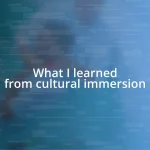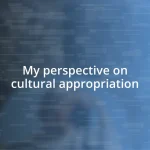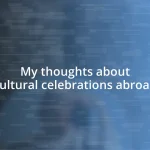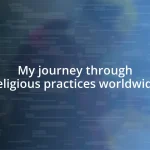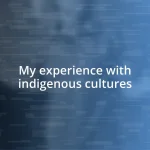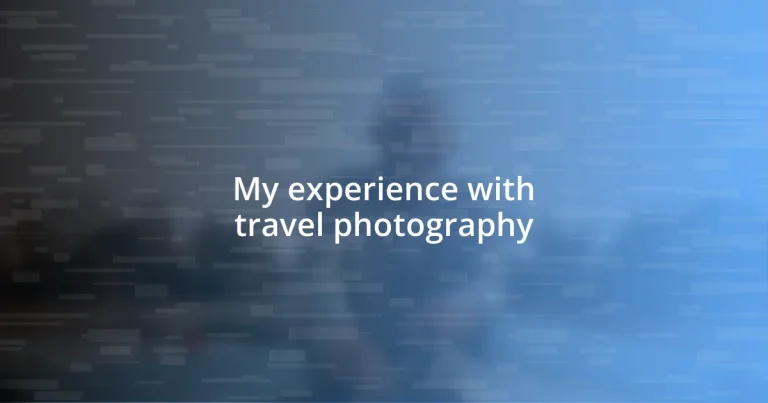Key takeaways:
- Travel photography is about storytelling; strong images convey feelings and engage with the essence of the location and its people.
- Choosing the right equipment, understanding techniques like the rule of thirds and leading lines, and thoughtful planning enhance photo quality and creative expression.
- Sharing photos online fosters connection and storytelling but requires attention to copyright and protecting one’s work through watermarking.
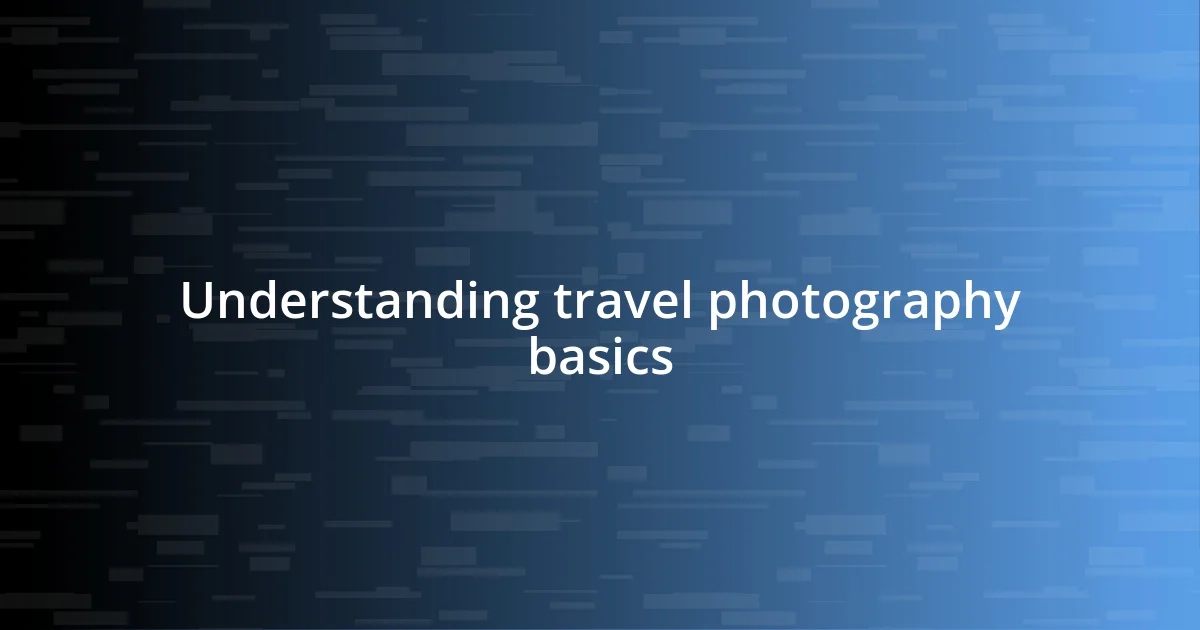
Understanding travel photography basics
Travel photography is all about storytelling; each photograph should reflect the essence of the place and moment. I remember standing at the edge of a breathtaking cliff in Iceland, the wind whipping through my hair as I captured the haunting beauty of the landscape. In that moment, I realized that great travel photography isn’t just about composition or lighting but conveying a feeling.
Consider your subject carefully. Is it the vibrant street markets of Thailand or the serene beaches of Spain that excite you? I once found myself captivated by a street performer in Lisbon; his passion transformed my ordinary photo into a vibrant narrative that bordered on alive. Choosing the right subject can evoke emotions that resonate long after the trip ends.
It’s essential to understand your equipment, but don’t let it intimidate you. I’ve seen incredible shots taken with just a smartphone, proving that creativity often outweighs gear. Have you ever thought about how an unexpected angle can entirely change the mood of a picture? Taking a moment to think about your surroundings can lead to images that feel both personal and universal.

Choosing the right equipment
When it comes to choosing the right equipment, I always start with my camera body. The decision often depends on how much weight I’m willing to carry around. During a trip to the mountains, I opted for a lighter mirrorless camera instead of my heavier DSLR. It made such a difference while trekking, allowing me to focus on capturing that stunning sunrise without feeling weighed down.
Lenses are equally crucial; the choice can dramatically affect the look of your photos. I once traveled with a prime lens that had a fixed focal length. It challenged me to think creatively and move around to find the best angle. The results were exhilarating, as each shot felt intentional and personal. I learned that the right lens can transform ordinary scenes into extraordinary images if you embrace its limitations.
Tripods shouldn’t be overlooked either. They provide stability, especially in low-light situations or during long exposure shots. I vividly remember standing in low light in a bustling city square, using my tripod to capture the lights trailing from moving cars. That stability allowed for a deeper, more immersive photograph that truly brought the scene to life.
| Equipment | Pros |
|---|---|
| Camera Body | Lightweight options make it easier to carry |
| Lenses | Create transformative images depending on their type |
| Tripods | Stabilize shots, particularly in low light |

Planning your photography trips
When planning my photography trips, I’ve learned that preparation is key to capturing those unforgettable moments. I always start with research, checking out the best times to visit certain locations to coincide with favorable lighting conditions. For instance, while planning my recent trip to the lavender fields in Provence, I intentionally timed my visit for the late afternoon. The golden hour bathed everything in a soft, ethereal glow, making my photos truly magical.
Here’s a handy checklist I’ve developed over the years for planning my photography trips:
- Research Locations: Identify key spots for potential shots.
- Weather Check: Track forecasts to anticipate lighting conditions.
- Timing: Schedule visits during sunrise or sunset for optimal natural light.
- Local Events: Look for festivals or events that can add cultural depth to your images.
- Packing List: Make a list of essential equipment to avoid last-minute packing stress.
I also think about how my approach can shift based on the people I’ll encounter. On one trip to Morocco, I spent time understanding the local culture before reaching for my camera. This mindfulness not only deepened my connection with the community but also resulted in candid shots that beautifully conveyed their everyday life. Sometimes, the best photographs come from being fully present in the moment rather than just the act of taking a picture.
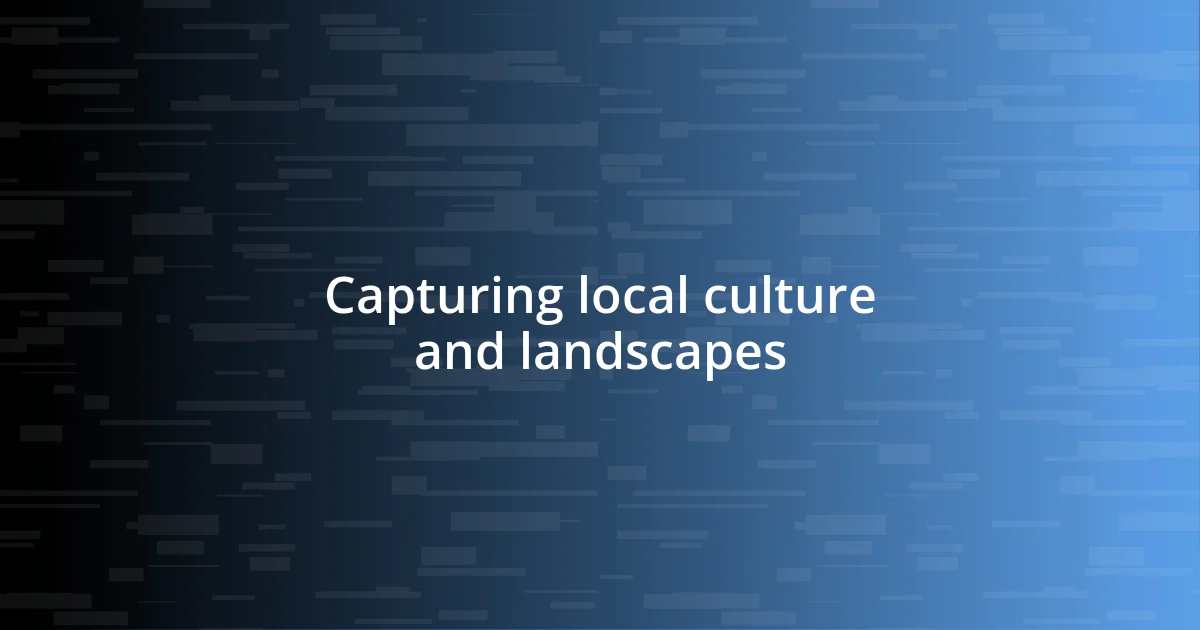
Capturing local culture and landscapes
Capturing local culture is more than just snapping a photograph; it’s about telling a story that resonates with the spirit of a place. While wandering through a bustling market in Bangkok, I was struck by the vivid colors of fruits and spices, but it was the vendors’ smiles and their interactions that truly brought the scene to life. I asked myself, “How can I show not just what I see, but how these people experience their day-to-day?” That question drove me to engage with them, to understand their lives, resulting in images that spoke volumes beyond the frame.
The landscapes themselves offer a canvas upon which culture and nature intertwine. I recall a trip to the Scottish Highlands, where mist-shrouded mountains met ancient stone structures that whispered tales of the past. One moment stands out vividly: capturing a lone shepherd tending to his flock against the backdrop of rolling hills. That image didn’t just show Scotland’s beauty; it encapsulated a way of life that feels timeless. Looking back, I realize those extra moments taken to breathe in the scenery, allowing myself to soak it all in, added depth to my photography.
In this journey, I often find myself reflecting on the essence of place versus people. Does one take precedence over the other? On a recent visit to Japan, the delicate cherry blossoms framed both the landscape and the local festivals, blending nature with vibrant human expression. As I positioned my camera, I made a conscious choice to include both a stunning sunset and the crowds celebrating beneath the trees. This experience reinforced my belief: capturing local culture and landscapes is like weaving a tapestry; every thread—each person, each view—adds to the overall picture, making it rich and compelling.

Techniques for stunning travel photos
Utilizing the right techniques can dramatically elevate the quality of your travel photos. One technique that I often rely on is the rule of thirds. This simple guideline encourages you to position key elements along imaginary lines dividing your frame into thirds. In my experience photographing the vibrant streets of Lisbon, placing a lively street performer off-center created a visual tension that drew viewers in. Have you ever tried this method? If you haven’t, you might be surprised at how it transforms a standard shot into something more dynamic.
Another technique that I absolutely love is playing with perspectives. Don’t be afraid to get low or find a high vantage point. I remember being in Santorini, crouching down to capture the iconic blue-domed roofs against a backdrop of the endless Aegean Sea. From that angle, the colors popped, and the photo embodied the essence of holiday bliss. This approach made me realize that a simple change in perspective can shift a photograph from ordinary to extraordinary. Why not challenge yourself to find new angles during your next trip?
Lastly, incorporating leading lines can guide the viewer’s eye through your image, creating a sense of depth and intrigue. On one of my hikes through the lush landscapes of New Zealand, I vividly remember using the winding paths to draw attention to the majestic mountains in the background. This technique not only added a three-dimensional feel to my photos but also evoked the journey I’d taken to get there. Have you ever experimented with leading lines? I encourage you to look for pathways, rivers, or even shadows that naturally guide the eye; they may just bring your images to life!

Editing photos for impact
Editing photos for impact is where the magic truly happens. One evening, after capturing the lively streets of Marrakech, I sat down with a few of my favorite shots. By adjusting the contrast and saturation, I was able to enhance the vibrant colors of the spices and textiles, making them pop with life. Have you ever noticed how a little tweak in editing can transform a photograph from flat to striking?
I often find myself diving into the world of cropping during my editing sessions. On a trip to Barcelona, there was a stunning mural that I photographed, but the broader scene felt cluttered. When I cropped it tightly around the mural, I allowed the vivid art to take center stage. The relief of that bustling background falling away was palpable; suddenly, the viewer could focus on the details and emotions conveyed within the artwork itself. Isn’t it fascinating how a little trimming can elevate a photo’s narrative?
Lastly, I’m a strong advocate for using presets to establish a mood. After visiting the serene beaches of Bali, I experimented with different presets that calmed the colors and highlighted the soft, golden light of sunset. The soothing tones reflected the tranquility I felt at that moment. If you haven’t yet tried creating or exploring presets, consider how they could enhance the storytelling aspect of your travel photography. Don’t you think capturing the essence of your experiences is worth a few extra edits?

Sharing your travel photography online
Sharing your travel photography online can be a rewarding yet challenging experience. I remember posting a stunning sunrise shot from my hike up Mount Fuji. The sky was a canvas of pinks and oranges, and I paired it with a heartfelt caption about my journey. The response was overwhelming; friends and followers began to share their own sunrise moments. Isn’t it incredible how one photo can connect us through shared experiences?
Social media platforms have transformed the way we present our travel photos. I often find myself scrolling through Instagram, marveling at the creativity of others. Each post serves as a reminder that storytelling is just as important as the image itself. Last summer, I shared a candid moment of a local market in Thailand, capturing the energy and vibrancy surrounding me. By inviting viewers into my experience, I felt like I was sharing a piece of my adventure. Have you ever thought about how a simple caption can enhance the story behind the image?
Lastly, while sharing is essential, protecting your work is equally important. After posting a few of my favorite shots from a trip to the Scottish Highlands, I noticed some of them shared without credit. It made me realize the importance of watermarking and being mindful of copyright. Taking steps to preserve my photography not only boosts my confidence, but it also sets a standard for others. Has this ever happened to you? Protecting your art ensures it’s valued and respected in the online community.
